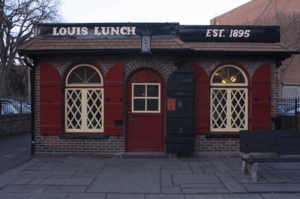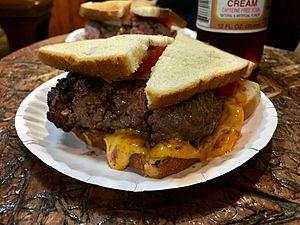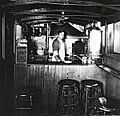Louis' Lunch facts for kids
Quick facts for kids Louis' Lunch |
|
|---|---|

Louis' Lunch landmark building
|
|
| Restaurant information | |
| Established | 1895 |
| Current owner(s) | Lassen family |
| Head chef | Jeff Lassen |
| Food type | Hamburgers |
| Dress code | Casual |
| Street address | 263 Crown Street |
| City | New Haven |
| State | Connecticut |
| Postal/ZIP code | 06511 |
| Country | United States |
| Seating capacity | 30 |
| Reservations | Not taken |
| Other information | Cash only establishment |
Louis' Lunch is a famous restaurant in New Haven, Connecticut. It's known for its hamburgers! This place claims to be the very first restaurant in the United States to serve hamburgers. It also says it's the oldest hamburger restaurant around.
It started as a small lunch wagon in 1895. It was one of the first places to sell steak sandwiches too. The owners of Louis' Lunch say the first hamburger was made in 1900. A customer was in a hurry and asked for a quick lunch to go.
In 1917, Louis' Lunch moved into a brick building. This building used to be a place where leather was made. Later, in 1975, the restaurant moved again to 263 Crown Street.
The hamburgers are cooked on special old machines. They use original cast iron broilers from 1898! The toast for the burgers is made in a 1929 toaster. Louis' Lunch has even sent information to the Library of Congress about their claim to inventing the hamburger.
Contents
The Story of Louis' Lunch
Louis Lassen was born in 1865 and came to New Haven from Denmark in 1886. He was a blacksmith, but he also sold food. He started by selling butter and eggs from a wooden cart.
In 1895, Louis began to sell lunch items from his cart. One day in 1900, a busy businessman came to his wagon. He needed a quick lunch to take with him. The Lassen family says the customer shouted, "Louie! I'm in a rush, slap a meatpuck between two planks and step on it!"
So, Louis put his special ground steak between two pieces of toast. He gave it to the man, and that's how the first hamburger was supposedly served!
In 1917, Louis moved his business into a brick building. This building used to be a tannery. In 1975, Louis' Lunch had to move again. It went to 263 Crown Street in New Haven.
In the 1950s, Ken Lassen, Louis's son, added cheese spread to the hamburger. Today, the great-grandchildren of Louis Lassen still own and run the restaurant.
How Louis' Lunch Works
The menu at Louis' Lunch is simple. They have "The Burger," potato salad, potato chips, and homemade pie. Their hamburgers are made from a special mix of five different cuts of beef.
The burgers are cooked in a unique way. They are flame broiled vertically. This means they cook standing up! The hamburgers are served with cheese, tomato, or onion. They come on two square pieces of toasted white bread.
Louis' Lunch uses very old equipment. Their flame broilers are made of cast iron and are from 1898. They were made by the Bridge and Beach, Co., in St. Louis, Missouri. These stoves have special hinged steel wires. These wires hold the hamburgers in place. This way, they cook on both sides at the same time.
The restaurant uses a sharp cheese spread, not sliced cheese. They also use a 1929 Savory Radiant Gas Toaster. This shows how much they value their history!
Louis' Lunch usually closes for vacation in August. For example, in 2014, it was closed from August 3 to September 1.
Who Invented the Hamburger?
Many people claim to have invented the hamburger. Besides Louis' Lunch, others like Charlie Nagreen and the Menches brothers also say they did. Some even say the hamburger came from Hamburg, Germany.
The hamburger became very popular at the 1904 St. Louis World's Fair. A newspaper, the New-York Tribune, wrote about it.
In 2000, the Library of Congress recognized Louis' Lunch. This happened after Representative Rosa DeLauro supported their claim. The Library of Congress stated that Louis Lassen sold the first hamburger and steak sandwich in the U.S. in 1900.
However, not everyone agrees. Some say a hamburger needs to be on a bun, not toast. But at that time, hamburger buns didn't even exist! They only appeared about 20 years later.
In 2006, a "mock trial" was held at a Hamburger Festival in Ohio. Louis' Lunch took it very seriously. They sent proof, including a letter from the New Haven Preservation Trust. They also mentioned the Library of Congress's recognition. But the evidence was not accepted. An online poll placed Louis' Lunch third.
It's hard to know for sure who invented the hamburger. There isn't much written history from that time. Also, many small vendors sold food at the World's Fair. It's possible that more than one person came up with the idea at the same time.
Images for kids






